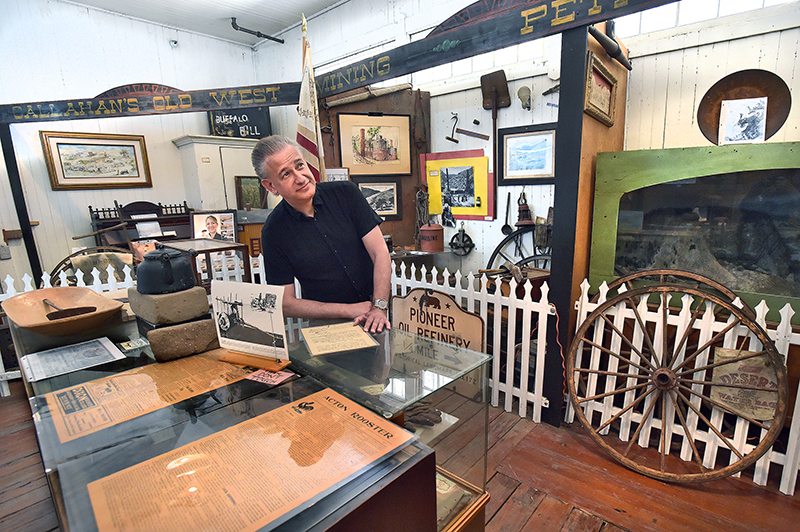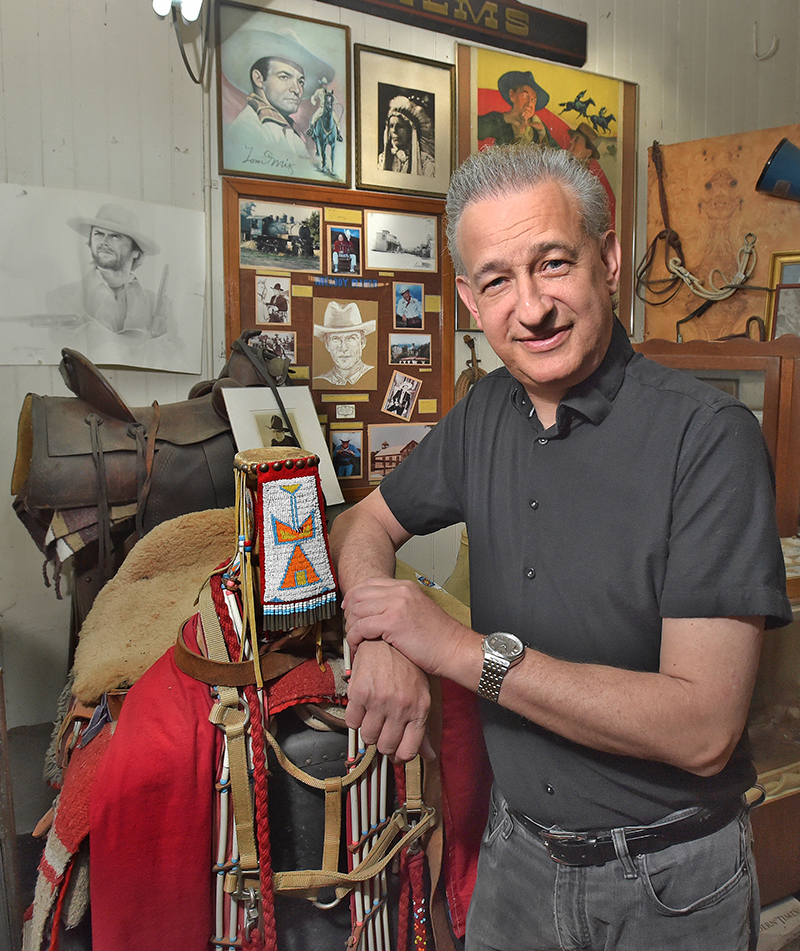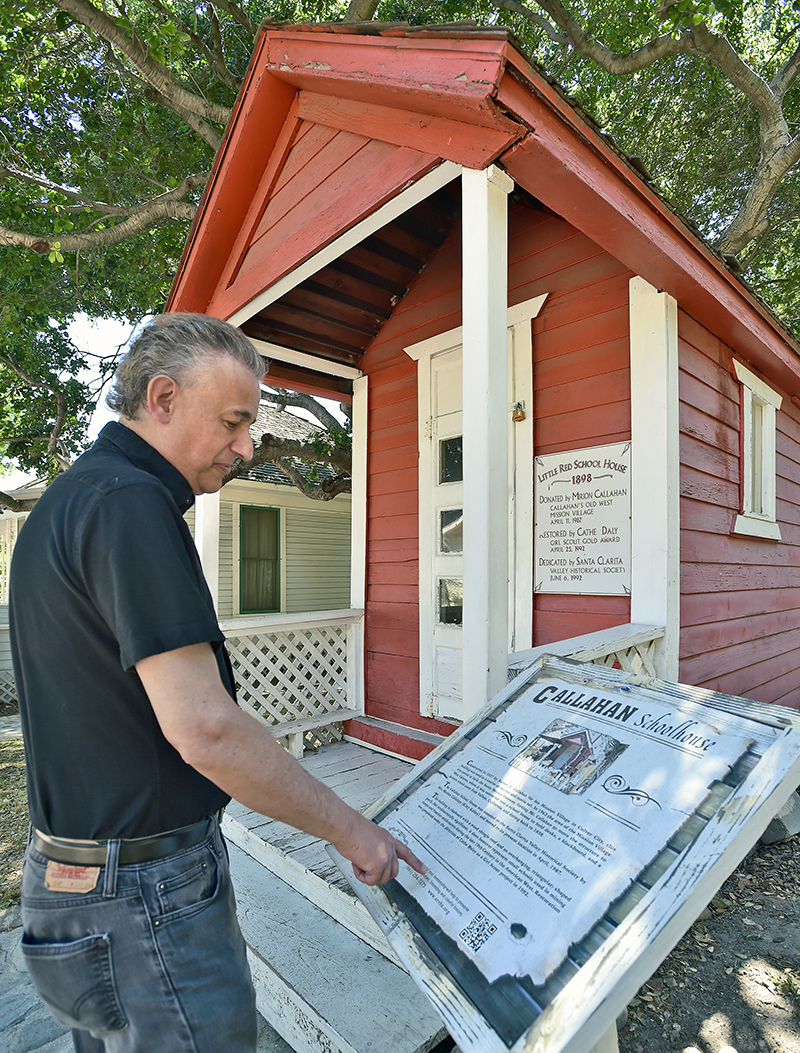|
|

Dr. Alan Pollack and the SCV Historical Society.
The Signal | Sunday, May 12, 2019.
|
Photos by Dan Watson / The Signal.
Dr. Alan Pollack, president of the Santa Clarita Valley Historical Society and an avid collector of historic newspapers, was born in New York City on the day of a news-making snowstorm. "I was born at 3 a.m. in a snowstorm," he said. "My parents told me that they had to struggle through the snow to get to the hospital. They told me the obstetrician was not pleased to be called to the hospital in the middle of the night in a snowstorm to deliver me." Pollack found an original copy of the New York Times dated the day after his birth that confirmed his parents account of the snowstorm. Moving to California Pollack's family moved to Southern California when he was about 1 year old. His only memories of New York are from summer vacation visits to his grandmother. Pollacks father was an aerospace engineer and the family lived mostly in the San Fernando Valley, Canoga Park, Sherman Oaks and North Hollywood. A graduate of Grant High School in Van Nuys, Pollack attended college at the University of California, Los Angeles, where he graduated in 1979 with a bachelor's degree in biochemistry. He was also named to Phi Beta Kappa, the oldest and most prestigious academic honor society in the United States. "Biochemistry seemed like a good way to get into medical school. It was my springboard to becoming a doctor," he said. "But I don't think I would have enjoyed it as a career." Internal medicine After his graduation from UCLA, Pollack attended the University of Texas Southwestern Medical School in Dallas. He graduated in 1983. "I was not born with a stethoscope in my crib; no one in my family had a career in medicine," he said. "I would have been as happy to be a left fielder for the Dodgers or a country music superstar." Pollack completed his internship and residency at Cedars-Sinai Medical Center in 1986. That same year, he became board-certified in internal medicine by the American Board of Internal Medicine. Pollack said he was always interested in medicine, and by "process of elimination, 1 just ended up in medicine." After more than 30 years as an internal medicine specialist for Kaiser Permanente in Panorama City, Pollack said he knows medicine was his destiny. "At the time it seemed like a good thing to do," he said. "Now I realize it was what I really was meant to do."
Finding the SCV Pollack purchased a home in Newhall in 1991. "When I finally got enough money to be able to afford a house, I wanted to get a house on a mountain with a view," he said. With his budget, the choices were limited. He looked at homes in the foothills north of Panorama City and then started looking in Santa Clarita. "I found a place I really loved and moved here," he said. "I currently live with my best pals: a beautiful Labrador retriever, a tennis ball-obsessed border collie and two cats." Pollack said despite growing up "just over the hill" from the Santa Clarita Valley, he doesn't remember ever visiting the area before he moved here. "I don't really remember Newhall. I wish I had memories of Newhall from the 1960s," he said. A love of history "I've been interested in current events and history since I was a kid," Pollack said. "I think I grew up in one of the most interesting decades in the 20th Century, the 1960s." Pollack describes himself as a youthful "news junkie" in the 1960s, following all the history-making events occurring at the time, such as the Vietnam War, the civil rights movement, the many assassinations and the race to the moon. "My first memory is of the Kennedy assassination when I was about 5," he said. "A week later my grandfather died, and I asked my mom why he didn't get a procession like Kennedy." Pollack began keeping copies of the newspapers with the historic headlines at an early age. "My parents took the Los Angeles Times," he said. "Every time a big story came out, I kept the paper with the headline. Even as a child, I had the perspective that if I keep this newspaper 30 years, it will be really interesting to look at." He also is a collector of rare books and has newspapers that date back to the 1600s. "I still have all the newspapers I saved as a kid and have evolved into an elite newspaper collector with newspapers containing some of the first reports of most of the major events in American history." As he grew older, Pollack also developed an interest in the Old West. "Especially after living in Texas, it became a big interest of mine. When I moved to Newhall and began reading about the history of the Santa Clarita Valley, I realized that Newhall really was the Old West." SCVHS It was only natural that his lifelong interest in history would lead Pollack into the arms of the Santa Clarita Valley Historical Society. "I took John Boston's history class probably three times and I ended up going over to the Saugus Train Station at Heritage Junction and telling (the SCVHS) I was interested in being a docent," Pollack said. "I knew a lot of SCV history, I had read so much about it. They didn't really have to train me." Pollack became president of the SCV Historical Society in July 2007.
St. Francis Dam disaster Among the many events that have shaped the history of the SCV, Pollack is most fascinated with the St. Francis Dam disaster. On March 12, 1928, the St. Francis Dam, built to hold a year's supply of water for the city of Los Angeles, collapsed and killed nearly 500 people as the water roared through the Santa Clarita and Santa Clara valleys out to the Pacific Ocean in Ventura. "It is the biggest story that ever happened in the SCV," he said. "It was a tremendous tragedy that was ultimately forgotten by the city of Los Angeles." Pollack said the disaster is an intriguing and interesting story. He describes the rise and fall of dam architect William Mulholland as "a real Shakespearian or Greek tragedy." Pollack's interest in the St. Francis Dam disaster led him to visit the Johnstown Flood National Memorial in Pennsylvania. The 1889 Johnstown flood is considered America's worst dam disaster. "The site has a visitors center, National Park Service rangers, a documentary film and a museum," he said. "When I got home, I read 'The Johnstown Flood' by historian David McCullough." Pollack discovered there were many parallels between the Johnstown and the St. Francis disasters. "There was poor dam building and there was tremendous destruction and loss of life," he said. After comparing the two disasters, Pollack was struck that the Johnstown event, which killed nearly 3,000 people, was well recognized in history and had a national memorial. The St. Francis Dam disaster, however, had little in the way of recognition. "The visit inspired me with the idea of getting a national memorial for the St. Francis Dam," he said. National recognition Seven years ago, after Pollack returned from his visit to Johnstown, he put out feelers on Facebook to see if there was any interest in working toward a national memorial. After years of working with elected officials representing the SCV and California, a bill authorizing the "Saint Francis Dam Disaster National Memorial and National Monument" was signed into law on March 12 of this year. "There are many people who helped with this effort, but without the drive and expertise of Dianne Erskine-Hellrigel, I don't think it would have happened," Pollack said. The future Pollack said the goal is to create a visitors center and memorial wall with the names of the victims. No money has been appropriated for the site, but Pollack said a foundation has been set up to help raise funds. For more information, visit Facebook and look up St. Francis Dam National Memorial Foundation. Pollack said the SCVHS can always use docents, donors and help to maintain the collection of historic buildings at Heritage Junction. "We have these buildings in Heritage Junction that would have been lost if people hadn't worked together to preserve them. The SCV Historical Society is the institutional memory of the community. It is a place for remembering and honoring the past," he said. "We preserve the past and we consider that important to the community." Currently, the SCVHS is looking for volunteers to assist in a massive archiving project of photos donated to the nonprofit by The Signal. The SCVHS is also looking to create a new, modern museum in the historic Pardee House. "Heritage Junction is a treasure. We want a modern museum that will resonate with adults and children," said Pollack. Visit Heritage Junction inside William S. Hart Park, 24101 Newhall Ave., Newhall, 91321, open 1-4 p.m. Saturdays and Sundays. For more information, visit https://scvhs.org.
|
See Also:
S.47 (Approved by Congress)
U.S. Senate Committee Substitute 10/2/2018
S1926: Bill Text
Sens. Harris, Feinstein Submit Memorial Bill 10-5-2017
HR2156: Bill Text
HR2156: Floor Debate
Knight, Brownley Resubmit Memorial Bill 4-26-2017
Graffiti Removal 2/2017
HR5244: Saint Francis Dam Disaster National Memorial Act (Knight 2016)
HR5244: Subcommittee Hearing 5-24-2016 (Pollack Story)
HR3153: Saint Francis Dam Disaster National Memorial and Castaic Wilderness Act (Knight 2015)
Press Conf.: HR3153 (Video 8-4-2015)
HR5357: Saint Francis Dam Disaster National Memorial Act (McKeon 2014) National Register Nomination (Obsolete)
Local Trio Lauded 2019
Pollack Feature 2019
|
The site owner makes no assertions as to ownership of any original copyrights to digitized images. However, these images are intended for Personal or Research use only. Any other kind of use, including but not limited to commercial or scholarly publication in any medium or format, public exhibition, or use online or in a web site, may be subject to additional restrictions including but not limited to the copyrights held by parties other than the site owner. USERS ARE SOLELY RESPONSIBLE for determining the existence of such rights and for obtaining any permissions and/or paying associated fees necessary for the proposed use.












